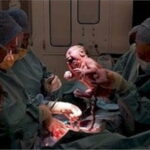In March of 2005, the AAFP (American Academy of Family Physicians) released a new set of recommendations for VBAC, based upon data from the Agency for Healthcare Research and Quality Evidence Report on Vaginal Birth After Cesarean. According to the document, “In 2003, after publication of AHRQ Evidence Report Number 71, the AAFP established a TOLAC Clinical Practice Guideline Panel (TOLAC Panel) composed of family physicians who were well-versed in practice guideline development and maternity care. The TOLAC Panel was charged with examining the evidence and developing a clinical practice guideline for pregnant women and their families, maternity care professionals, facilities, and policy-makers.
Included in the review were studies published between the 1980 NIH Consensus Development Conference on Cesarean Childbirth and March 2002 (an updated review was performed on data between 2002 and 2004, for which there were only 7 fair-quality articles). The evidence review resulted in five main recommendations, summarized here:
Recommendation 1: Women with one previous cesarean delivery with a low transverse incision are candidates for and should be offered a trial of labor (TOL). (Level A)
Recommendation 2: Patients desiring trial of labor after previous cesarean (TOLAC) should be counseled that their chance for a successful vaginal birth after cesarean (VBAC) is influenced by the following: (Level B)
Positive Factors (increased likelihood of successful VBAC) :
Maternal age Prior vaginal delivery (particularly prior successful VBAC)
Favorable cervical factors
Presence of spontaneous labor
Nonrecurrent indication that was present for prior cesarean delivery
Negative Factors (decreased likelihood of successful VBAC) :
Increased number of prior cesarean deliveries
Gestational age >40 weeks
Birth weight >4,000 g
Induction or augmentation of labor
Recommendation 3: Prostaglandins should not be used for cervical ripening or induction as their use is associated with higher rates of uterine rupture and decreased rates of successful vaginal delivery. (Level B)
Recommendation 4: TOLAC should not be restricted only to facilities with available surgical teams present throughout labor since there is no evidence that these additional resources result in improved outcomes. (Level C)
Recommendation 5: Maternity care professionals need to explore all the issues that may affect a woman’s decision including issues such as recovery time and safety. (Level C).
On the surface, most of the recommendations appear to fall into line nicely with ACOG’s current stance. While there are a few items which are unnecessarily discouraging – such as the negative predictors for VBAC, some of which are based upon very slight decreases in VBAC success rates and almost all of which can be nullified through good nutrition, choosing a supportive care provider and avoiding interventions – overall there are not many big surprises to be found. However, the AAFP makes one very bold and under-reported point in this document.
The item that stands out among the rest is recommendation 4 – TOL should not be restricted to facilities with round the clock surgical and anesthesia coverage. The AAFP is the first major medical association to openly admit that there is no evidence to back this practice. The enormity of this recommendation cannot be overemphasized. According to ICAN (the International Cesarean Awareness Network (www.ican-online.org) there are now a minimum of over 300 facilities across the nation denying VBAC to women based upon the recommendation from ACOG’s VBAC practice bulletin. The impact of ACOG’s position on this matter has been profound – countless women who believe VBAC to be the safest delivery option have been forced to make the choice between going under the knife for no medical reason, driving long distances to hospitals that do allow VBACs, and sometimes doing the birth alone. The most astonishing aspect of this issue is the admission of many hospital executives that it is based almost solely on liability, rather than safety, concerns, which is simply unconscionable given that the complication they are trying to prevent occurs at no higher a rate than almost any other pregnancy or birth complication. Yet, between woman and OB during prenatal visits, the denial of VBAC is being presented under the guise of safety.
Ultimately the greatest scam is the fact that, as the AAFP is so conveniently highlighting in recommendation 4, if a hospital isn’t equipped to deal with an emergency during a VBAC labor, they are not equipped to deal with any labor emergency. Any facility offering maternity services can and should offer VBAC as well.




